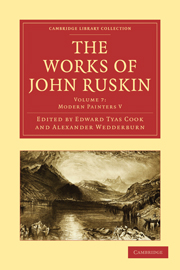Book contents
- Frontmatter
- Contents
- LIST OF ILLUSTRATIONS
- INTRODUCTION TO THIS VOLUME
- BIBLIOGRAPHICAL NOTE
- Modern Painters, Vol. V.
- PREFACE
- PART VI “OF LEAF BEAUTY”
- PART VII “OF CLOUD BEAUTY”
- CHAP. I THE CLOUD-BALANCINGS
- CHAP. II THE CLOUD-FLOCKS
- CHAP. III THE CLOUD-CHARIOTS
- CHAP. IV THE ANGEL OF THE SEA
- PART VIII “OF IDEAS OF RELATION:—FIRST, OF INVENTION FORMAL”
- PART IX “OF IDEAS OF RELATION:—SECOND, OF INVENTION SPIRITUAL”
- EPILOGUE (1888)
- APPENDIX
- Plate section
CHAP. I - THE CLOUD-BALANCINGS
Published online by Cambridge University Press: 07 September 2011
- Frontmatter
- Contents
- LIST OF ILLUSTRATIONS
- INTRODUCTION TO THIS VOLUME
- BIBLIOGRAPHICAL NOTE
- Modern Painters, Vol. V.
- PREFACE
- PART VI “OF LEAF BEAUTY”
- PART VII “OF CLOUD BEAUTY”
- CHAP. I THE CLOUD-BALANCINGS
- CHAP. II THE CLOUD-FLOCKS
- CHAP. III THE CLOUD-CHARIOTS
- CHAP. IV THE ANGEL OF THE SEA
- PART VIII “OF IDEAS OF RELATION:—FIRST, OF INVENTION FORMAL”
- PART IX “OF IDEAS OF RELATION:—SECOND, OF INVENTION SPIRITUAL”
- EPILOGUE (1888)
- APPENDIX
- Plate section
Summary
§ 1. We have seen that when the earth had to be prepared for the habitation of man, a veil, as it were, of intermediate being was spread between him and its darkness, in which were joined, in a subdued measure, the stability and insensibility of the earth, and the passion and perishing of mankind.
But the heavens, also, had to be prepared for his habitation.
Between their burning light,—their deep vacuity, and man, as between the earth's gloom of iron substance, and man, a veil had to be spread of intermediate being;—which should appease the unendurable glory to the level of human feebleness, and sign the changeless motion of the heavens with a semblance of human vicissitude.
Between the earth and man arose the leaf. Between the heaven and man came the cloud. His life being partly as the falling leaf, and partly as the flying vapour.
§ 2. Has the reader any distinct idea of what clouds are? We had some talk about them long ago, and perhaps thought their nature, though at that time not clear to us, would be easily enough understandable when we put ourselves seriously to make it out. Shall we begin with one or two easiest questions?
That mist which lies in the morning so softly in the valley, level and white, through which the tops of the trees rise as if through an inundation—why is it so heavy? and why does it lie so low, being yet so thin and frail that it will melt away utterly into splendour of morning, when the sun has shone on it but a few moments more?
- Type
- Chapter
- Information
- The Works of John Ruskin , pp. 133 - 143Publisher: Cambridge University PressPrint publication year: 2010First published in: 1903

